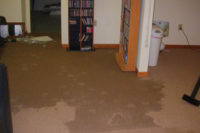Finding that "Sweet Spot" in Heat Drying during Restoration (Part 1)
Understanding the difference between heat energy and temperature


Evaporation requires considerably more heat than a simple temperature change. Evaporating a pint of water takes a little over 1000 BTUs. The reason it takes all these BTUs to evaporate water is because the water molecules need to absorb enough heat energy to push way from each other — they need to go from a liquid (close to each other) to a vapor (far apart).


Everyone dries with heat. “Everyone dries with heat” because water needs a substantial amount of heat energy to change from a liquid to a vapor. But keep in mind that a “substantial amount of heat” is not the same as a “high temperature”. In other words, the amount of heat energy that something contains is not the same thing as its temperature.
We wrote this 2-part article to help restoration professionals understand the application of supplemental heat in restoration drying. It gives restorers the background to understand how heat works and to get past some common heat related mistakes. Heat is quite often an emotional topic in the restoration industry. Many experienced professionals hold strong opinions on supplemental heat—for, or against.
Part 1 concentrates on the science of heat, water, and evaporation. The second part focuses on applications, along with some tips on using heat efficiently and profitably. This information should help guide your thinking within the existing legal climate.
Heat Energy
One way to measure the amount of heat energy is to use BTUs (British thermal units). A BTU is about enough heat to raise the temperature of a pint of water 1°F; one BTU is not a lot of heat energy. If you had a gallon of water that you wanted to heat from cool to hot; from 50°F up to around 120°F, you would add about 560 BTUs (8 pints x 70°F change). Of course, the source of the heat energy has to be hotter than the water in order for the heat energy to transfer to the water.
Evaporation requires considerably more heat than a simple temperature change. Evaporating a pint of water takes a little over 1000 BTUs. The reason it takes all these BTUs to evaporate water is because the water molecules need to absorb enough heat energy to push way from each other — they need to go from a liquid (close to each other) to a vapor (far apart). Figure 1 (above) shows this concept.
Evaporation does not require a temperature change; evaporation is a phase change. “Phase change” simply means water changes from the liquid phase to the vapor phase. A pint of water will evaporate (slowly) at 70°F and the water vapor will be at 70°F, all those 1000 BTUs are used to drive the phase change of liquid water into water vapor.
Here is an example showing temperature change and rapid (boiling) phase change of a pint of water (we’re going to go with the saying, “A pint’s a pound, the world around” here.) Heating the pint from 65°F up to 212°F takes close to 150 BTUs, but then evaporating that pint takes close to 1000 BTUs. Remember, the water stays at 212° all the while it is evaporating. That’s why your skin feels cool when water evaporates off it…the water vapor takes a lot of heat energy along with it when it leaves.
The heat energy it took to push the water molecules apart (changing the liquid to vapor) stays with the water molecules and is called latent energy. A pound of air at 70°F and 25% RH contains about 21 BTUs of heat energy. A pound of air at 70°F and 90% RH contains 32 BTUs. The wetter air has the same temperature, but about 60% more BTUs of heat energy. These extra BTUs are referred to as latent heat because they do not show up as a temperature change; they only show themselves in the higher moisture content. When technical people talk about removing latent heat or latent BTUs from the air, they’re just talking about making drier air.
Vapor Pressure
Vapors have a measurable pressure; called vapor pressure. In restoration, when we talk about vapor pressure, it’s assumed to be water vapor. At any given air temperature there is a maximum amount of water vapor that can exist within the air, this vapor-saturated air measures in at 100%RH. Saturated air has the maximum vapor pressure normally possible (at that temperature.) Unsurprisingly, the vapor pressure of saturated air is called its saturation vapor pressure. Under some abnormal conditions, air can measure a little more than 100%RH. This is the “supersaturated” air people occasionally talk about.
Vapor pressure in air is known as a partial pressure. All the gases and vapors in air have their own partial pressures. All these partial pressures add-up to give us the atmospheric pressure (14.7 psi at sea level). The partial pressure of water vapor is just a small part of the total atmospheric pressure: At 70°F the saturation (100%RH) partial pressure of water vapor is 0.36 psi; 90°F it is 0.70 psi; and at 110°F the saturation partial pressure of water vapor is 1.28 psi.
Vapor pressure is sometimes measured in inches of mercury (in. Hg). One inch of mercury is equal to about one half psi.
The weight of the water vapor in the air is usually measured in grains per pound (GPP). This is grains of water per pound of air. One grain is 0.065 grams, or about the same as an average drop of water. Your psychrometric chart can tell you it takes around 13 or 14 cubic feet to get a pound of air (it mostly depends on the temperature of the air.)
When the temperature of the air is raised, the amount of moisture in the air (GPP) doesn’t immediately change, so the vapor pressure doesn’t change, but the maximum possible vapor pressure goes up (more grains of water vapor can exist in the warmer air). By raising the temperature, you’ve put more heat energy into the system. Some of that energy goes into any available water and pushes more water molecules apart. This makes more water vapor, and the GPP in the air will eventually go up
Liquid water has its own vapor pressure in a thin boundary layer above it, and the vapor pressure is tied to temperature. If you raise the temperature of the water in a wet material, you raise the available vapor pressure at the surface of the water.
Vapor pressure differential drives the evaporation rate- You want high vapor pressure at the surface of the wet material, and low vapor pressure in the surrounding air. It should be clear by now that temperature is one of the main controls over vapor pressure.
The temperature at the surface of a wet material determines the saturation vapor pressure of the evaporation from it. The higher the surface temperature is, the higher the vapor pressure of evaporation can be. And, one way to know the vapor pressure in the air is to know the air temperature and RH (vapor pressure is found on the psychrometric chart next to grains per pound). Assuming adequate airflow, the bigger the difference is between the wet material’s vapor pressure and the vapor pressure in the air the faster the evaporation rate. By the same rule, the smaller the difference is, the slower the evaporation rate.
When using heat to dry materials, the goal is to maximize vapor pressure differential by adding heat to provide fast evaporation without excessive temperature rise. On the other hand, a dehumidifier based method focuses on maximizing the vapor pressure differential through reducing the vapor pressure in the air.
Here is how the heat control strategy compares to a moisture control strategy: Since the equilibrium moisture content (EMC) of wood and other hygroscopic materials is highly linked to the relative humidity of the air, relative humidity is a good guide to the eventual lowest possible wood moisture content during drying. For example, air with 23%RH will eventually dry wood to approximately 4.8% MC. Air at 80°F and 23% RH has a humidity ratio of 35 gpp and will eventually dry wood to an EMC of 4.9%. Air at 100°F and 23% RH has a humidity ratio of 65 gpp and will eventually dry wood to an EMC of 4.7%, but the evaporation rate at 100°F will be much faster because the warmer surfaces produce higher surface vapor pressure. Faster evaporation means faster drying…you may be wondering what the problem here could be. It’s only a potential problem: The 100°F job requires more careful monitoring to avoid the heat-related issues discussed in part 2.
Bringing the Heat
“How much heat?” is a simple question, but the answer varies from job to job... and from start to finish on the same job. These job to job changes are discussed in part 2, but the main reason for the “start to finish” change is because when materials are wet, the evaporating moisture protects them from overheating. As a job progresses and dries, heat can cause problems in some materials if their temperature gets out of control.
Warm air is usually used to transfer heat into the structure (and to the moisture) via convection, much like a household convection oven: The heat source warms the air, and then the air warms the structure and the liquid water. Some small area “spot” heating can be done using infrared (IR) heat lamps, but heat lamps are too inefficient for larger areas. Heat lamps use infrared radiation to apply the heat; this is line-of-sight transfer. Radiated heat goes where it is aimed, and without heating the air on the way. Convection (hot air) and radiation (IR) are the two main methods to apply heat energy in restorative drying.
There are several different ways to generate convective heat on a drying job. Fuel burning, direct fired heating units put the combustion gases in the heated air stream. Indirect fired heaters separate the combustion chamber from the heated air stream, similar to a home’s forced air furnace. Hydronic heating equipment uses a burner to heat a liquid (usually a food grade propylene glycol/water blend) then pumps the hot liquid, via hoses, to one or more fan coil units located inside the structure. And, of course, there are electrically powered heating units. Some heating systems emphasize focusing the heated air directly on wet materials while others warm the entire affected area.
The non-electric heat sources can be designed to use any commonly available fuel, such as natural gas, propane, or diesel fuel. Some allow field modifications to change the fuel type. Electricity can be taken from the affected structure or supplied via a portable generator.
Knowing how to use heat, airflow, and moisture removal to fine-tune the evaporation rate can guide your equipment choices as the drying job progresses.
Part 2 continues into the application area and offers some heating tips.
Looking for a reprint of this article?
From high-res PDFs to custom plaques, order your copy today!









